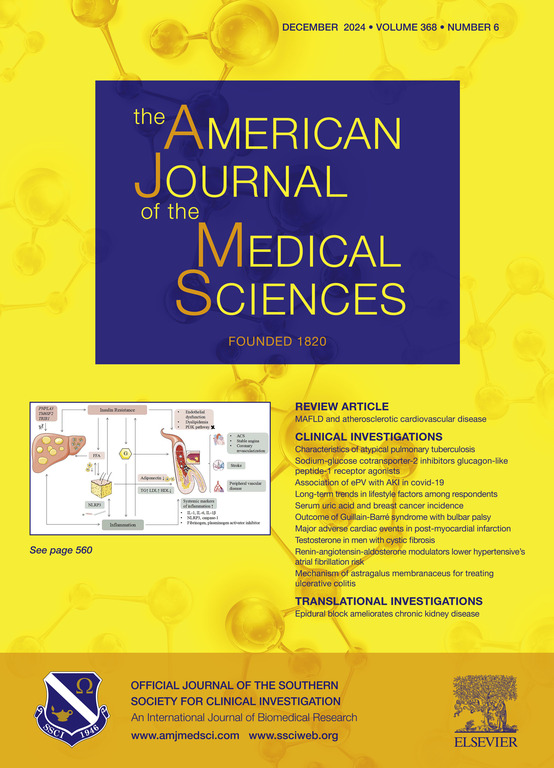接受经皮冷冻消融术的肾细胞癌患者的胸膜并发症:对其发生率和风险因素的回顾性分析。
IF 2.3
4区 医学
Q2 MEDICINE, GENERAL & INTERNAL
引用次数: 0
摘要
理论依据:我们的临床实践观察表明,经皮肾冷冻消融术(PRC)后胸膜并发症的发生率很高:目的:确定经皮肾脏冷冻消融术后胸膜并发症的发生率以及与术后胸膜并发症相关的潜在风险因素:这是一项回顾性队列分析,研究对象是2016年至2022年期间在两家三级医院系统接受PRC治疗的患者。在数据库中收集了患者特征、放射学和临床数据以及手术技术,以确定潜在的风险因素:在规定的纳入期内,共有285名患者接受了312例PRC手术。其中,10 例手术(3.2%)导致胸膜并发症,均表现为胸腔积液。在这些并发症中,3 名患者(1%)需要进行胸腔引流。胸膜并发症风险增加的相关因素包括肿瘤平均大小较大(4.3 厘米 vs 2.7 厘米,P = 结论:肿瘤平均大小越大,胸膜并发症风险越高:经皮肾冷冻消融术引起胸膜并发症的情况很少见。为进一步降低风险,在可行的情况下,应避免较高的插入点(T12 以上)和使用两个以上的冷冻探针。经皮肾冷冻消融术后出现新呼吸道症状的患者应考虑胸膜并发症。本文章由计算机程序翻译,如有差异,请以英文原文为准。
Pleural complications in patients with renal cell carcinoma undergoing percutaneous cryoablation: A retrospective analysis of its incidence and risk factors
Rationale
Observations from our clinical practice indicate a notable occurrence of pleural complications post-percutaneous renal cryoablation (PRC).
Objective
To identify the incidence of pleural complications following PRC and potential risk factors associated with post-procedural pleural complications.
Materials and Methods
This was a retrospective cohort analysis of patients undergoing PRC at two tertiary hospital systems between 2016 and 2022. Patient characteristics, radiological and clinical data, and procedure techniques were collected in a database to identify potential risk factors.
Results
A total of 285 patients were identified who underwent 312 PRC procedures during the specified inclusion period. Among these, 10 procedures (3.2 %) led to pleural complications, all manifesting as pleural effusions. Of these complications, 3 patients (1 %) required pleural drainage. Factors associated with an increased risk of pleural complications included a larger mean tumor size (4.3 cm vs 2.7 cm, P = <0.001), cryoprobe applicator entry at the T10-T11 level as opposed to lower sites (P = 0.029), and a higher median number of cryoprobe applicators employed (3.5 vs 2.0, P = 0.001). Moreover, individuals who experienced pleural complications had a longer median hospital stay (4.0 vs 0, P ≤ 0.001) and a higher rate of blood transfusions (40 % vs 0.7 %, P ≤ 0.001).
Conclusion
Pleural complications from percutaneous renal cryoablation are rare. To further reduce the risk, higher insertion points (above T12) and utilizing more than two cryoprobe applicators should be avoided when feasible. Pleural complications in patients with new respiratory symptoms after PRC should be considered.
求助全文
通过发布文献求助,成功后即可免费获取论文全文。
去求助
来源期刊
CiteScore
4.40
自引率
0.00%
发文量
303
审稿时长
1.5 months
期刊介绍:
The American Journal of The Medical Sciences (AJMS), founded in 1820, is the 2nd oldest medical journal in the United States. The AJMS is the official journal of the Southern Society for Clinical Investigation (SSCI). The SSCI is dedicated to the advancement of medical research and the exchange of knowledge, information and ideas. Its members are committed to mentoring future generations of medical investigators and promoting careers in academic medicine. The AJMS publishes, on a monthly basis, peer-reviewed articles in the field of internal medicine and its subspecialties, which include:
Original clinical and basic science investigations
Review articles
Online Images in the Medical Sciences
Special Features Include:
Patient-Centered Focused Reviews
History of Medicine
The Science of Medical Education.

 求助内容:
求助内容: 应助结果提醒方式:
应助结果提醒方式:


